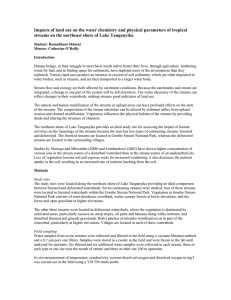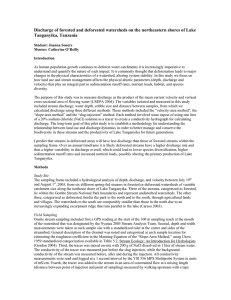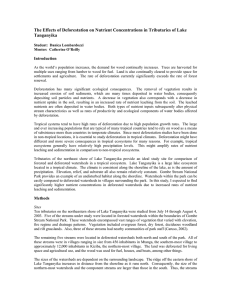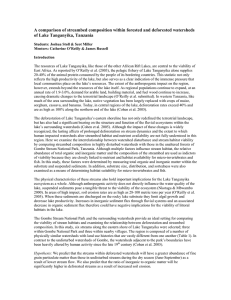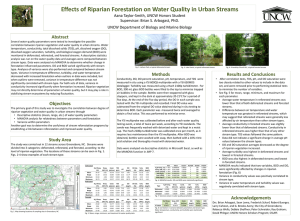A Survey Comparing Streams from Forested and Deforested Watersheds to... Impact of Land Use Change on the Northeastern Shore of...
advertisement
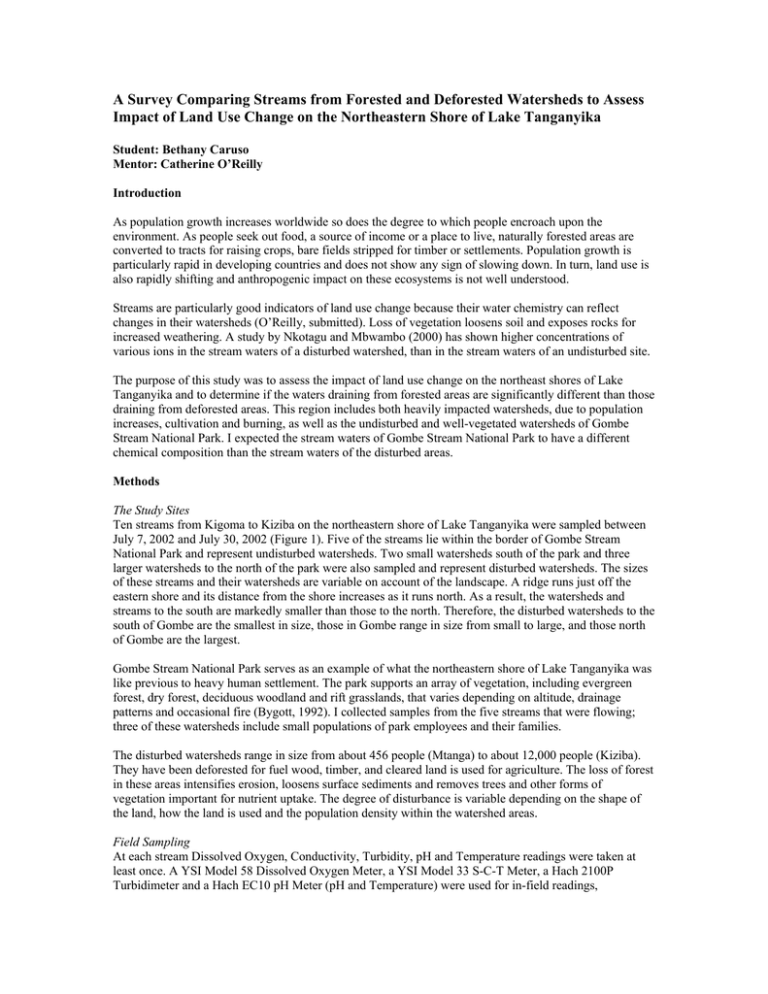
A Survey Comparing Streams from Forested and Deforested Watersheds to Assess Impact of Land Use Change on the Northeastern Shore of Lake Tanganyika Student: Bethany Caruso Mentor: Catherine O’Reilly Introduction As population growth increases worldwide so does the degree to which people encroach upon the environment. As people seek out food, a source of income or a place to live, naturally forested areas are converted to tracts for raising crops, bare fields stripped for timber or settlements. Population growth is particularly rapid in developing countries and does not show any sign of slowing down. In turn, land use is also rapidly shifting and anthropogenic impact on these ecosystems is not well understood. Streams are particularly good indicators of land use change because their water chemistry can reflect changes in their watersheds (O’Reilly, submitted). Loss of vegetation loosens soil and exposes rocks for increased weathering. A study by Nkotagu and Mbwambo (2000) has shown higher concentrations of various ions in the stream waters of a disturbed watershed, than in the stream waters of an undisturbed site. The purpose of this study was to assess the impact of land use change on the northeast shores of Lake Tanganyika and to determine if the waters draining from forested areas are significantly different than those draining from deforested areas. This region includes both heavily impacted watersheds, due to population increases, cultivation and burning, as well as the undisturbed and well-vegetated watersheds of Gombe Stream National Park. I expected the stream waters of Gombe Stream National Park to have a different chemical composition than the stream waters of the disturbed areas. Methods The Study Sites Ten streams from Kigoma to Kiziba on the northeastern shore of Lake Tanganyika were sampled between July 7, 2002 and July 30, 2002 (Figure 1). Five of the streams lie within the border of Gombe Stream National Park and represent undisturbed watersheds. Two small watersheds south of the park and three larger watersheds to the north of the park were also sampled and represent disturbed watersheds. The sizes of these streams and their watersheds are variable on account of the landscape. A ridge runs just off the eastern shore and its distance from the shore increases as it runs north. As a result, the watersheds and streams to the south are markedly smaller than those to the north. Therefore, the disturbed watersheds to the south of Gombe are the smallest in size, those in Gombe range in size from small to large, and those north of Gombe are the largest. Gombe Stream National Park serves as an example of what the northeastern shore of Lake Tanganyika was like previous to heavy human settlement. The park supports an array of vegetation, including evergreen forest, dry forest, deciduous woodland and rift grasslands, that varies depending on altitude, drainage patterns and occasional fire (Bygott, 1992). I collected samples from the five streams that were flowing; three of these watersheds include small populations of park employees and their families. The disturbed watersheds range in size from about 456 people (Mtanga) to about 12,000 people (Kiziba). They have been deforested for fuel wood, timber, and cleared land is used for agriculture. The loss of forest in these areas intensifies erosion, loosens surface sediments and removes trees and other forms of vegetation important for nutrient uptake. The degree of disturbance is variable depending on the shape of the land, how the land is used and the population density within the watershed areas. Field Sampling At each stream Dissolved Oxygen, Conductivity, Turbidity, pH and Temperature readings were taken at least once. A YSI Model 58 Dissolved Oxygen Meter, a YSI Model 33 S-C-T Meter, a Hach 2100P Turbidimeter and a Hach EC10 pH Meter (pH and Temperature) were used for in-field readings, respectively. At eight of the sites, these readings were taken at least three times at the mouth and at points upstream. At least three water samples were collected from each stream at the mouth and at points upstream at points 10 to 25 meters apart in acid-washed containers for later analysis of alkalinity, nutrients and chlorophyll a. Cobbles were also collected from each stream mouth for biomass analysis. Nutrient Analysis Unfiltered water was used to determine alkalinity using the Hach Sulfuric Acid titration Method, and to determine Total Phosphorus using the Hach PhosVer 3 and Acid Persulfate Digestion Method. Water was filtered and the filter kept for later chlorophyll a analysis. Filtered water was then used to determine Nitrate (Hach Cadmium Reduction Method), Nitrite (Hach Diazotization Chromotropic Acid Method), Orthophosphate (Hach PhosVer 3 Method) and Silica (Silicomolybdate Method). All readings were taken on a Hach DR/2010 Portable Datalogging Spectrophotometer. Statistical Analysis T-tests were performed to compare the y-distributions of forested and deforested watersheds for nutrients. I will later take watershed area and population into consideration using ANOVA analysis. Results Field Sampling Stream temperatures ranged between 19.8 degrees C and 25 degrees C which are colder than the temperatures reported for the lake this time of year which are generally around 27 degrees C. pH values ranged between 6.98 and 8.09 which are also less than pH values for the lake (9.0). Conductivity values ranged from 12 umohs to as high as 130 umhos. Turbidity values ranged from 1.55 ntu to 36.1 ntu. These values are difficult to interpret because the amount of spectators moving in the stream during the time of sampling in the developed/disturbed sites likely affected the amount of suspended matter in the samples. Dissolved oxygen values ranged from 6.72 mg/L to 8.12 mg/L. Nutrient Analysis Nitrate, nitrite, total phosphorus, reactive phosphorus and silica values were calculated for all streams, though the amount of silicate in the streams interfered with the test for total phosphorus so those results are not presented here. Average nutrient loads for each stream are indicated in Table 1. Site Status 9 Mtanga A Deforested 11 Mtanga Deforested 14 Bwavi Forested 22 Mkenke Forested 23 Kasekera Forested 26 Rutanga Forested 28 Mitumba Forested 30 Mwongongo Deforested 33 Bugambo Deforested 35 Kiziba Deforested NO3 –N mg/L 0.105 (0.0265) 0.055 (0.0369) 0.0525 (0.0094) 0.0567 (0.0115) 0.05333 (0.0153) 0.04333 (0.0058) 0.03333 (0.0058) 0.02 (0.0) 0.38667 (0.0305) 0.02667 (0.0115) NO2 –N mg/L 0.01925 (0.0021) 0.0175 (0.0029) 0.0165 (0.0026) 0.0157 (0.0006) 0.018 (0.0026) 0.018 (0.007) 0.01867 (0.0006) 0.022 (0.002) 0.02367 (0.0116) 0.02033 (0.0021) SRP PO4 3 –P mg/L 0.13 (0.0634) 0.15 (0.0683) 0.2875 (0.066) 0.07667 (0.0116) 0.09667 (0.0643) 0.08 (0.05) 0.15 (0.01) 0.14 (0.0173) 0.19 (0.052) 0.21333 (0.0153) Si mg/L 1.85 (2.2353) 2.675 (1.9653) 2.0 (0.3916) 2.133 (1.5503) 3.1 (0.9534) 4.4 (0.1) 4.6 (0.0) 3.567 (1.365) 3.9 (0.3) 8.7667 (0.0153) Table 1. Values in the above table are the averages of at least three samples per site at the mouths of each stream and at points within 100m upstream. Values in parenthesis are standard deviations. The site numbers indicate the location of the watershed in relation to Kigoma Bay (9 being the 9th watershed north of Kigoma Bay). The names adjacent to the site numbers are the local names of the streams or villages in the watershed. Nitrate values are significantly higher for deforested site 33 (Kiziba) than for any of the other sites. Nitrate values from two of the deforested watershed were significantly lower than those of the forested watersheds. Nitrite values were also highest at site 33 and were generally higher at the deforested sites. Phosphorus values are significantly higher for site 14 (Bwavi), which is a forested site. On the day of sampling, women were upstream washing with soaps. I attribute the high values for phosphorus to this specific activity and do not believe the results presented here reflect the average discharge value of phosphorus for this stream. The mean silica value for site 35 (Kiziba) is markedly higher than all of the other sites. The mean concentration for this site is 8.9 mg/L whereas the next highest value is 5.6 mg/L at the mouth of site 11 (Mtanga). Also, the forested site 22 (Mkenke) shows a high standard deviation for Silica. Silica values were low for all upstream samples (1.0 mg/L Si and 1.5 mg/L Si) and higher at the mouth (3.9 mg/L Si). The mouth of this stream flowed from a forested area to a pebble beach. Mean values of nutrients from both forested and deforested areas were calculated to see if there was any variability in nutrient loads from these different watershed types. The mean nutrient loads from deforested watersheds were higher than mean nutrient loads from forested watersheds (Table 2). Status Deforested Forested NO3 –N mg/L * 0.11412 (0.1358) 0.04813 (0.0122) NO2 –N mg/L * 0.02024 (0.0051) 0.01731 (0.0032) SRP PO4 3 mg/L ** 0.16176 (0.0553) 0.14750 (0.0972) Si mg/L 3.92941 (2.7919) 3.16875 (1.329) Table 2. The above table compares mean nutrient loads from forested and deforested watersheds. Values in parenthesis are standard deviations. * indicates a significant difference between the forested and deforested watersheds. ** Indicates a significant difference when the outlier site (#14) is excluded. Statistical Analysis T-tests were conducted to determine if forested areas were significantly different than deforested areas in regard to nutrient loads. For Nitrate p= 0.0623 and for Nitrite p=0.0298. For Soluble Reactive Phosphorus, site 14 was excluded because people were using the stream for washing at the time of sampling and the values for P that were calculated do not likely reflect the stream’s regular load of P. Without site 14, the forested and deforested sites were significantly different in terms of P (p=0.0003). Silica was not statistically significant (p=0.2779) when all samples were included. However, when upstream samples from sites 9 and 11 (which were still partially frozen at the time of analysis) were excluded, the forested and deforested sites were significantly different (p= 0.01). Unlike site 14 (Bwavi) where the beach was all cobbles, sites 9 and 11 have sandy beaches. Therefore, the discrepancy in values along the stream is more likely due to the method of analysis than an actual variation along the stream. Discussion Anthropogenic impacts are the cause of variation in stream nutrient load between the forested and deforested sites. A loss of plant matter in deforested sites loosens soils, reduces number of N-fixing plants and lessens the amount of organic matter in soils. As a result, deforested areas have higher P concentrations in some sites, considerably lesser nitrate concentrations. Humans also contribute to nutrient loads. Use of soaps adds to P concentrations and human waste adds to N concentrations. The nutrient values for the streams in the present study varied from those reported by Kimbadi et al. (1999) in their study of small rivers of northwestern Lake Tanganyika. Mean Nitrite and Soluble Reactive Phosphorus values were higher in the streams on the eastern side whereas mean Nitrate and Silica values were higher in the rivers on the western side of the lake. Their values represent an average over a 15-month period of sampling whereas the numbers I have collected represent only one day of sampling per site during the dry season. Nonetheless, the varied results encourage future work to investigate how the watersheds in the northwest vary from those on the northeast shore of Lake Tanganyika. Previous studies on streams of northeastern Lake Tanganyika have solely focused on comparing Mitumba (forested) and Mwongongo (deforested) watersheds (O’Reilly, Nkotagu and Mbwambo). The present study has included more watersheds from deforested and forested areas to asses human impact and shows that forested (pristine) watersheds have significantly different stream discharge than do deforested (disturbed) watersheds. This study has also shown variability within the deforested and forested regions, and I will later address population and watershed size as potential causes of this variability. Future work should address how variation in water chemistry from forested and deforested areas affects local ecology, both in streambeds and the lake proper. Flora and Fauna in the forested and deforested areas seemed variable along and in the streams (personal observation). Additionally, studies should also look at where these streams interact with the lake and what organisms are present in these regions. Acknowledgements This study was funded by the NSF grant #ATM9619458 (The Nyanza Project). I would like to thank my mentor, Catherine O’Reilly, for her great help and patience in the field and lab, as well as her imperative knowledge of Swahili, which I could not have done without. I also wish to thank Willy Mbemba for his assistance in the lab and in the field, Issa Petit for his boat skills in the field, RJ Hartwell for his patience and computer help, and Ava and Saskia for their assistance with tanks and pumps for incubations. Thank you Climlake for letting me use your pump and collection bottles. I would also like to acknowledge the Wesleyan-Dana Grant committee for recognizing this project and providing me with funding to really take advantage of this opportunity. Thank you Lindsay, Michelle, Pete, Carolyn, Emmanuel, Fidelis, Kristine and Leah for helpful words and smiles. Lastly, I give a huge thanks to the Nyanza Project for this unforgettable experience. References Bygott, D. 1992. Gombe Stream National Park. Tanzania National Parks/African Wildlife Foundation. Pp: 8, 9, and 14-34. Nkotagu, H and K. Mbwambo. 2000. Hydrology of Selected Watersheds along the Lake Tanganyika Shoreline. A Special Study on Sediment Discharge and its Consequences for the Lake Tanganyika Biodiversity Project. O’Reilly, C. submitted. Using carbon and Nitrogen Isotopes in Lake Sediments to Detect Land Use Change. Limnology and Oceanography.
